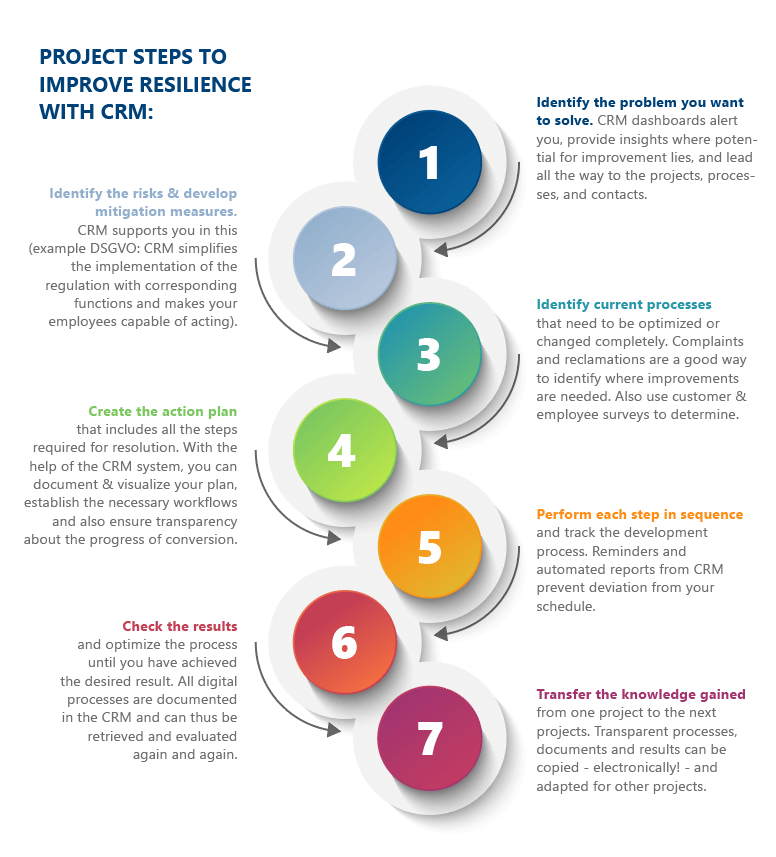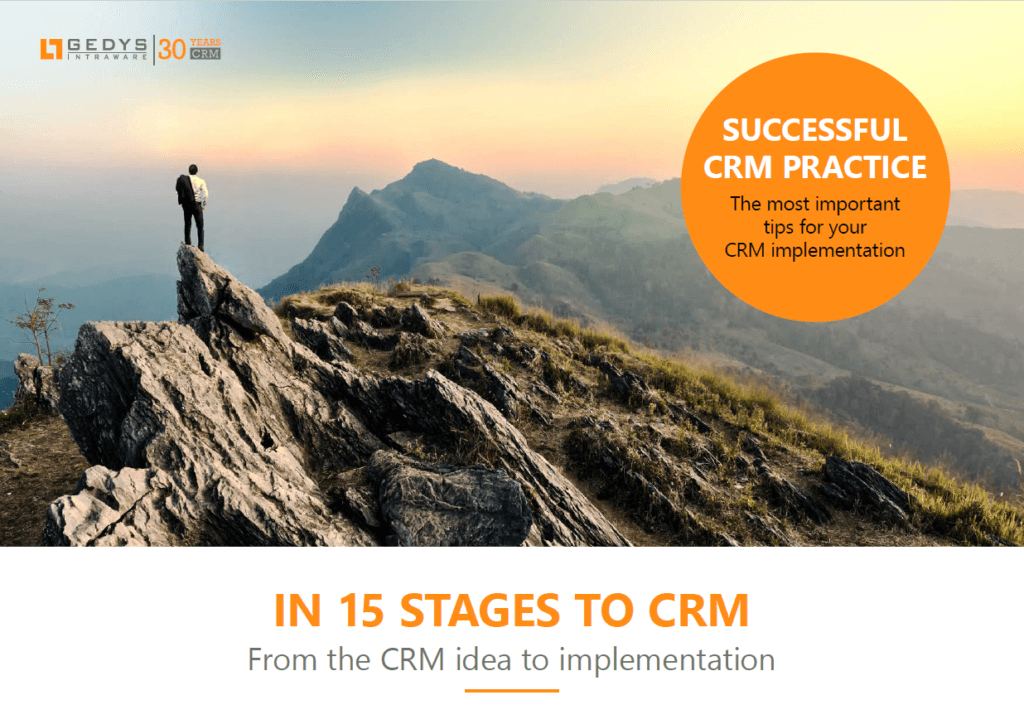Can you achieve resilience with CRM as a foundation in business?
Allover the world, driven by the ongoing COVID-19 pandemic, companies are looking for new ways to generate revenue and to stand up to the competition. While some companies are successful, others are struggling. The question is which business models prove to be resilient in the long term. Which are currently successful models and can you achieve resilience with CRM software as a basis? We will explore these questions in the following blog article.
Table of Contents
1. Which business models have proven resilient in the Corona crisis?
At the start of the COVID 19 crisis, the German economy experienced its worst slump since quarterly accounting began in 1970, according to the BDI Quarterly Report III 2020. But it was able to recover much faster than economies in other countries because, according to the Tagesspiegel, the shutdown was shorter, short-time work was used, Germans remained comparatively mobile, the state’s financial cushion was larger and the German government put together a rescue package more quickly than other governments. But these reasons are not a good explanation for why some businesses were more successful than others.
Right in the first phase of the crisis, many companies were forced to fundamentally change their way of working. The lockdown with exit restrictions necessitated a far-reaching shift to work at the home office, which in turn brought new working practices and new ways of communicating. Due to the contact restrictions, several companies had to switch to contactless delivery models or to a hybrid constellation (online ordering with pick-up on site or at a packing station). For this purpose, new structures and suitable tools had to be found at short notice.
In the next stage, the economy was affected by travel restrictions around the world, workers could not get to their place of work, supply chains were disrupted, machines were shut down. With the use of video conferencing tools and remote software, companies were able to replace on-site visits, and maintenance work was also possible. When offices and production facilities were finally allowed to reopen, people returned to their workplaces. Now analyses and evaluations were required in order to make an assessment of the situation.
Most companies realized that processes that had worked before had suddenly become unusable. But only those companies that changed their way of thinking arrived at the creation of new products, services and business models via the approach: “What if we could solve this problem in a completely different way?
This innovative strength, the ability to organize employee collaboration from different locations as well as the fact that they have sufficient financial reserves, a high-performance IT department or a corresponding IT service provider with cloud offerings , were the decisive factors for a quick adaptation to the new conditions and thus the key to success.
Business models that have worked well since the corona crisis:
- Online trading:
Sell & deliver goods or services directly to end consumers (= B2C such as Amazon, Zalando, but also Edeka, Rewe etc.) - Hybrid sales:
Sell products or services online to business customers (= B2B), delivery contactless or remote installation, where possible also delivery on site in compliance with hygiene regulations - Services that use the Internet for themselves:
– Delivery services (such as Lieferheld, Hellofresh or Flaschenpost)
– Sales platforms (such as ebay, Etsy, Rakuten)
– Booking platforms (such as Airbnb, booking.com, myticket.de, eventim.de) - Online services:
– Streaming or gaming services (such as Netflix, Prime, Sky)
– Cloud and hosting services (such as Microsoft, Hetzner, Raidboxes, 1&1, GEDYS IntraWare) - Production of digital consumer goods:
– Hardware such as .B tablets, smartphones, laptops (such as Apple, Samsung, Xaomi)
– Software such as games and apps (such as FIFA, Fortnite, Houseparty, WhatsApp, Instagram) - Software development (including licenses and services)
- Consulting
- Outdoor sales and event models:
– mobile sales booths, mobile test centers
– Catering establishments with outdoor seating
– Events on outdoor areas (e.B. concerts with sufficient distance between the participants and admission controls)
2. What are the prerequisites for corporate resilience?
The word resilience generally refers to the ability to manage crises, while the term corporate resilience refers to an organization’s ability to recover from any type of disruption and continue to work efficiently. A company is usually considered resilient if its performance does not deteriorate during a period of crisis that can last for several months. But being able to maintain the current state of a company for a manageable period of time is not enough today to survive in the long term, the cut-throat competition is too great.
Anyone who sees crises as an opportunity can emerge stronger. This is also evident in the Resilience Check 2020 by Microsoft and the Federal Association of German Employers’ Associations (BDA).
According to Microsoft, these factors play a major role in this:
- Adaptability of the organization
Companies have introduced new ways of working in the Corona pandemic and have become more flexible.
Keyword New Work: Employees work together, although they sit in different places, via a central system and use modern means of communication such as video conferencing, chat and collaboration tools. - Leadership & Trust
Managers trust their employees and give them the freedom to try out new things.
Keyword freedom: Free time created by the use of time-saving tools can and may now be used sensibly for the development of ideas. - Clarity about business processes
Employees understand their company’s strategy as well as their own tasks and responsibilities.
Keyword transparency: A central customer management system with a comprehensive role and rights system is an important building block that not only defines responsibilities but also provides each individual employee with an overview of his or her task area. - Mindset of employees
Employees are open to digital technologies and quickly find their way around difficult situations.
Keyword acceptance: A modern, largely intuitive software combined with goal-oriented process support, reduces obstacles in employees and ensures the comprehensive use of an application. Furthermore, smart change management and a wide range of training courses help. - Agile IT & Infrastructure
Companies have invested in IT infrastructure and are technically better equipped than before the crisis.
Keyword Basement: New tools, service providers and cloud services minimize the workload, not only in the IT department. The merging of the new tools and services with the central customer management software to form a best-of-breed solution provides a solid foundation for mastering future crises well.
The most important prerequisites for resilience are therefore the will to change and adapt to new circumstances as well as the willingness to make changes in and with all departments of the company.
Added to this is the (not exactly easy) task of recognizing trends early on and reacting to them, or better yet, becoming trendsetters themselves and staying ahead of others. Even if they are very small niches that could be tapped, the success of a company depends on whether it is willing and also able to take risks in order to find new markets and customers. This requires a certain amount of creativity, flexibility and courage. But it also requires a lot of commitment, commitment and continuous reflection.
3. How can you improve adaptability to changes in your company?
In the past, management has determined which tasks a company takes on, which goals are pursued and which means are needed for this. Today and in the near future, however, the customer determines which tasks a company performs.
Therefore, to achieve resilience, you need not only a resilient infrastructure across the organization – that is, management, people, machines and IT, and the right connections and processes in between – but also the ability to adapt to changing customer needs and expectations. A critical factor in building a resilient business model is a strong understanding of how customers interact with your business.
Companies that opened up new communication channels with their customers before the crisis were able to use them effectively during the pandemic, especially in the online sector. Even those who had invested in long-term customer relationships , writes Bitkom, could benefit from it, because loyal customers were willing to support their providers. This was well illustrated by the example of many sports studios whose members continued to pay even though they could not use their fitness clubs.
It is therefore imperative to take a close look at the own customer loyalty model and the previous customer approach and to check where and how optimizations are possible. By using customer relationship management software, or CRM for short, you gain valuable insights into what your customers expect and need from your product or service. With this information, you can develop a better product or service for them, which increases your chances of long-term success .
Of course, even with a software, the behavior of consumers can not be predicted one hundred percent, but you can get an overview of the previous behavior with a CRM system and draw conclusions from it. And if you use the CRM system to keep an eye on online and offline channels and use automation, you will be able to meet demand more efficiently.
4. How can you achieve resilience with CRM as a foundation?
If you want your organization to survive the next crisis excellently, you must first examine and understand your current situation. Have you ever put everything to the test and involved not only your own department, but all departments in the company? Then you have an idea of how much energy you had to spend on it.
Here, too, a CRM system is of great use. Important information from your company is stored there every day and can be retrieved and evaluated at any time. By integrating your ERP system and connecting additional channels and sources, you can use additional data for analysis. This allows you to see through which channels interested buyers came to you, which leads became customers and which products or services were successful or not.
If you need more extensive information from your customers or employees, surveys provide you with important insights. You can do this either via your website, via your newsletter or a survey tool. The results can be collected, networked and graphically displayed in CRM and also be reported out of the system. This gives you a first data basis that you need to uncover your potential in order to be able to develop innovative products that fit exactly to the needs of your customers.
The prerequisite for being able to properly exploit the possibilities of a CRM is well-maintained data. The CRM supports you with data imports, by comparison with address databases, with sanction lists, duplicate checks as well as the complete documentation of your correspondence, your campaigns, newsletters and mailings as well as the storage of various documents and attachments to your processes.
The CRM system becomes the “source of truth” for sales, marketing and service. At the same time, it promotes optimal cooperation between the teams with end-to-end transparency of processes and contact persons as well as time-saving workflows – even with agile working methods. It makes your employees’ work easier and collects valuable information that allows you to identify deviations and determine causes and backgrounds. Insights that you use as a basis for gradually improving the resilience of your company. Your successful path to resilience with CRM.
5. This is what a CRM system does for your company
Result: Now you know why CRM systems are so important for companies and why achieving resilience with CRM is possible. CRM software helps you learn more about your customers’ wishes, work more effectively, save time, adapt faster to new circumstances and thus be more resilient in the long term.


